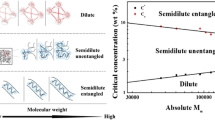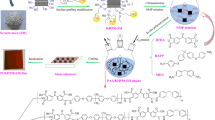Abstract
The cross-linked model of SiO2 and polyimide (SiO2–PI) was constructed through molecular dynamics simulation, and the mixture model of SiO2 and PI (SiO2/PI) was also constructed for comparative analysis. The SiO2–PI model was constructed at the atomistic level to simulate the real polymerization procedure. By comparing the radial distribution function and interaction energy of the two models, covalent bonds have been formed and the reliability of the cross-linked model was confirmed. The mechanical properties of the two materials are calculated by the molecular dynamics and the improvement in mechanical properties has shown after the cross-linking. This improvement in the mechanical properties of the materials is analyzed theoretically with the conclusions of morphology and interaction energy. By comparing with similar materials, the results obtained in this paper are convincing. Thus, the cross-linked model can provide theoretical guidance for the improvement in the material properties.






Similar content being viewed by others
References
Katti A, Shimpi N, Roy S et al (2006) Chemical, physical, and mechanical characterization of isocyanate cross-linked amine-modified silica aerogels. Chem Mater 18(2):285–296
Randall JP, Meador MAB, Jana SC (2011) Tailoring mechanical properties of aerogels for aerospace applications. ACS Appl Mater Interfaces 3(3):613–626
Fei Z, Yang Z, Chen G et al (2018) Preparation of tetraethoxysilane-based silica aerogels with polyimide cross-linking from 3, 3′, 4, 4′-biphenyltetracarboxylic dianhydride and 4, 4′-oxydianiline. J Sol–Gel Sci Technol 85(3):506–513
Zhifang F, Zichun Y, Guobing C et al (2018) Preparation and characterization of glass fiber/polyimide/SiO2 composite aerogels with high specific surface area. J Mater Sci 53(18):12885–12893
Guo HQ, Meador MAB, Mccorkle LS et al (2012) Tailoring properties of cross-linked polyimide aerogels for better moisture resistance, flexibility, and strength. ACS Appl Mater Interfaces 4:5422–5429
Leventis N, Sotiriou-Leventis C, Zhang G et al (2002) Nano-engineering strong silica aerogels. Nano Lett 2(9):957–960
Duan Y, Jana SC, Lama B et al (2013) Reinforcement of silica aerogels using silane-end-capped polyurethanes. Langmuir 29(20):6156–6165
Rahman R, Haque A (2013) Molecular modeling of crosslinked graphene–epoxy nanocomposites for characterization of elastic constants and interfacial properties. Compos B Eng 54(9):353–364
Duan K, Li Y, Li L et al (2018) Pillared graphene as excellent reinforcement for polymer-based nanocomposites. Mater Des 147:11–18
Choi J, Yang S, Yu S, Shin H, Cho M (2012) Method of scale-bridging for thermos elasticity of cross-linked epoxy/Si C nanocomposites at a wide range of temperatures. Polymer 53:5178–5189
Zhang Y, Wang Q, Wang C et al (2011) High-strain shape memory polymer networks crosslinked by SiO2. J Mater Chem 21:9073
Yang S, Yu S, Cho M (2010) Sequential thermoelastic multiscale analysis of nanoparticulate composites. J Appl Phys. https://doi.org/10.1063/1.3467524
Yang S, Cho M (2008) Scale bridging method to characterize mechanical properties of nanoparticle/polymer nanocomposites. Appl Phys Lett. https://doi.org/10.1063/1.2965486
Chueangchayaphan N, Ting KA, Yusoff M et al (2019) Influence of Al2O3 particle size on properties of thermoplastic starch–TiO2–Al2O3 composites. Polym Bull. https://doi.org/10.1007/s00289-019-02688-0
Kim B, Choi J, Yang S et al (2015) Influence of crosslink density on the interfacial characteristics of epoxy nanocomposites. Polymer 60:186–197
Kim B, Choi J, Yang S et al (2017) Multiscale modeling of interphase in crosslinked epoxy nanocomposites. Compos B Eng 120:128–142
Odegard GM, Clancy TC, Gates TS (2005) Modeling of the mechanical properties of nanoparticle/polymer composites. Polymer 46(2):553–562
Choi J, Shin H, Yang S et al (2015) The influence of nanoparticle size on the mechanical properties of polymer nanocomposites and the associated interphase region: a multiscale approach. Compos Struct 119(119):365–376
Li C, Browning AR, Christensen S et al (2012) Atomistic simulations on multilayer graphene reinforced epoxy composites. Compos A 43(8):1293–1300
Shin H, Yang S, Chang S et al (2013) Multiscale homogenization modeling for thermal transport properties of polymer nanocomposites with Kapitza thermal resistance. Polymer 54(5):1543–1554
Yarovsky I, Evans E (2012) Computer simulation of structure and properties of crosslinked polymers: application to epoxy resins. Polymer 43(3):963–969
Wang Z, Lv Q, Chen S et al (2016) Effect of interfacial bonding on interphase properties in SiO2/epoxy nanocomposite: a molecular dynamics simulation study. ACS Appl Mater Interfaces. https://doi.org/10.1021/acsami.5b11810
Wu C, Xu W (2006) Atomistic molecular modelling of crosslinked epoxy resin. Polymer 47(16):6004–6009
Raaska T, Niemela S, Sundholm F (1994) Atom-based modeling of elastic constants in amorphous polystyrene. Macromolecules 27(20):5751–5757
Theodorou DN, Suter UW (1986) Atomistic modeling of mechanical properties of polymeric glasses. Macromolecules 19(1):139–154
Tsai J-L, Tzeng S-H (2008) Characterizing mechanical properties of particulate nanocomposites using micromechanical approach. J Compos Mater 42(22):2345–2361
AIAA (2008) Multi-scale analysis to characterize mechanical properties of nanoparticle/polymer composites. AIAA J. https://doi.org/10.2514/6.2008-21012
Acknowledgements
This work was supported by the National Natural Science Foundation of China (Grant No. 51702364) and Independent Project of Naval University of Engineering, China (Grant No. 425517K152).
Author information
Authors and Affiliations
Corresponding author
Additional information
Publisher's Note
Springer Nature remains neutral with regard to jurisdictional claims in published maps and institutional affiliations.
Rights and permissions
About this article
Cite this article
Luo, Z., Yang, Z., Fei, Z. et al. Investigating mechanical properties of cross-linked SiO2 and polyimide through molecular dynamics simulation. Polym. Bull. 77, 5213–5225 (2020). https://doi.org/10.1007/s00289-019-03014-4
Received:
Revised:
Accepted:
Published:
Issue Date:
DOI: https://doi.org/10.1007/s00289-019-03014-4




